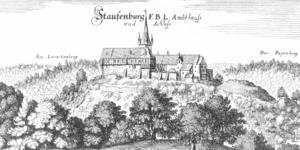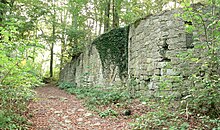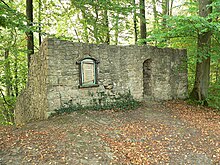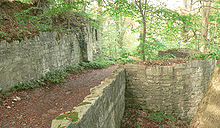Stauffenburg (Harz)
| Stauffenburg | ||
|---|---|---|
|
Stauffenburg as a Merian copper engraving from 1654, the gate area on the right, the keep in the middle |
||
| Alternative name (s): | Staufenburg | |
| Creation time : | 11th century | |
| Castle type : | Hilltop castle | |
| Conservation status: | ruin | |
| Place: | Seesen - Münchehof | |
| Geographical location | 51 ° 49 '17 " N , 10 ° 10' 1" E | |
| Height: | 346 m above sea level NN | |
|
|
||
The Stauffenburg , also called Staufenburg , is the ruin of a former hilltop castle near Seesen - Münchehof in the Lower Saxony district of Goslar .
Its structural beginnings are believed to be in the 11th century. Today, the fortifications, which have never been besieged, are ruins of a castle with remnants of walls that have been restored. Its stones have been removed to build other buildings in the area since the 18th century.
Geographical location
The Stauffenburg castle ruins are located around 3 km south-southwest of the village of Münchehof , a district of the city of Seesen (district of Goslar) and around 2.8 km north-northwest of Gittelde ( district of Göttingen ). It is located on the wooded Burgberg ( 346 m above sea level ), a conical crest of the Westerhöfer Bergland . The B 243 runs about 1.6 km east of the ruin beyond the Stauffenburg domain in the Markau valley between Münchehof and Gittelde . The Harz Mountains begin to the east . The small housing estate that is located there is also known as “Stauffenburg”. However, this is not its own direct locality and is therefore a district of Münchehof.
Building description
The old access path to the castle is partly a ravine and is accompanied in the upper part by elevations on the side, which may have been a kind of preliminary fortification. The once walled castle complex has the dimensions of about 85 m × 30 m. In the entrance area there are restored walls of two semicircular towers in which there are loopholes for earlier cannons. The also restored lower wall remains of the approximately 20 m × 3 m gate kennel have been preserved to some extent . Of the core Burg mainly just knee to hip-high wall radicals of 1 m thickness are present, which were previously substantially higher and as the outer defense wall served. They are likely to have represented the lower floors of individual castle buildings, the upper floor of which had timber-framed structures . This can be seen well on the Merian copper engraving of the castle from 1654. The square keep with 2 m thick walls has a base area of 7 m × 7 m. During a restoration it was rebuilt up to a height of about 3 m. A basement is visible in it, which presumably served as a dungeon . In some places the old stone pavement of the castle courtyard is still present in small areas.
In 2019, students of geoinformatics and geodesy at the University of Hanover carried out a relief mapping of the fortifications. Such measurements of archaeologically significant systems for the production of a virtual 3D model have been taking place for decades in cooperation between the University of Hanover and the Lower Saxony State Office for Monument Preservation .
history
Origin in the Middle Ages
The first constructions of the castle were probably built in the 11th century by the Counts of Katlenburg . Over the centuries it has been constantly expanded and rebuilt. The function of the Stauffenburg was to protect the Harz mining in nearby Gittelde and to secure the Thuringian military road , which ran below the Seesen castle from southeast along the Harz to Nordhausen . The name Stauffenburg was first mentioned in the region in 1154. It is the name of a ministerial family that is mentioned in a document from Heinrich the Lion . This indirectly suggests the existence of the castle. Henry the Lion pledged the castle to noble pledges, and it is said to have been the seat of robber knights at times . After his fall in 1180, the castle, like the other Guelph properties in the area, fell to Emperor Friedrich Barbarossa . In 1193 she came to the Archdiocese of Magdeburg . At the beginning of the 13th century the Reichstruchsess Gunzelin von Wolfenbüttel sat in the castle. When his son was lord of the castle, he called himself "Guncelinus de Stoyphonborg" (Stauffenburg) in 1254 . From the 14th century, the castle served as the administrative center of the ducal office for mining and metallurgy in Gittelde. Between 1495 and 1522 the castle became the widow's seat of Duchess Elisabeth zu Stolberg , the mother of Duke Heinrich the Elder of Braunschweig-Wolfenbüttel . It brought miners and blacksmiths from Stolberg and Ellrich to Gittelde and thus promoted the mining industry with its extraction and processing of silver, copper and iron ore . She expanded the castle from the proceeds of the Harz mining industry.
Love nest in modern times
In the castle, Duke Heinrich the Younger of Braunschweig-Wolfenbüttel , also derisively called "the wild Heinz von Wolfenbüttel", hid his lover Eva von Trott for nine years . He had a total of ten children with her, most of whom were born during their secret stay at the Stauffenburg from 1532–1541. Before that, she was the lady- in- waiting to the Duchess. When the relationship with the Duke became known in 1532, the Westphalian noblewoman was sent home from the Duke's seat in Wolfenbüttel, where she never arrived. On the way she explained in the ducal castle Gandersheim that she was afflicted by the plague and thereby faked her death. Her alleged coffin was solemnly buried in Gandersheim Abbey, while the lady-in-waiting went to the lonely Stauffenburg. The love affair could not be kept secret in the long run and became public. Martin Luther accused the duke of fornication and blasphemy because of the sham funeral .
An ancient linden tree next to the castle was named Eva-Linde after Eva von Trott . It is located to the side in front of the castle gate on a small hill (on the Merian copper engraving to the right of the castle), on which the stump of an ancient linden tree about 2 m in diameter stands.
Widow's Residence, Prison, and Decay
From 1569 the castle became the widow's seat for the sister of Duke Heinrich the Younger of Braunschweig-Wolfenbüttel Margarete . She was married to the Silesian Duke Johann von Munsterberg and Oels . She converted the castle into an infirmary and helped people in need until her death in 1580.
The Protestant abbess of Gandersheim Monastery, Margarethe von Warberg, served a life sentence at the castle in the 16th century. She was imprisoned for murder from 1588 until her death in 1597, alleged to have killed her illegitimate child.
From 1600 to 1713 the castle served as an official administration, which was then moved to one of the outworks below the castle. The castle was used as a prison until 1778 . After that, the facility began to decline. The stones were used, among other things, to build a domain that is located below the castle.
literature
- Friedrich Stolberg : Stauffenburg In: Fortifications in and on the Harz from early history to modern times , Hildesheim, 1968, pp. 380–383
- Kurt Brüning , Heinrich Schmidt (ed.): Handbook of the historical sites of Germany . Volume 2: Lower Saxony and Bremen (= Kröner's pocket edition . Volume 272). 4th, improved edition. Kröner, Stuttgart 1976, ISBN 3-520-27204-0 .
- Hans Adolf Schultz : Castles and palaces of the Braunschweiger Land. 3. Edition. Waisenhaus-Buchdruckerei und Verlag, Braunschweig 1983, ISBN 3-878840128 , pp. 111-113.
- Ernst Andreas Friedrich : The Stauffenburg and the Liebenburg . In: If stones could talk , Volume I, Landbuch-Verlag, Hanover 1989, ISBN 3-7842-03973 , pp. 189–191.
- Margret Zimmermann, Hans Kensche: Castles and palaces in Hildesheimer Land . Hildesheim, 2001, pp. 160-161
Web links
- Entry by Stefan Eismann zu Stauffenburg in the scientific database " EBIDAT " of the European Castle Institute
- Description at burgenwelt.de
- Reconstruction drawing
Individual evidence
- ↑ Felix Gräber: On the trail of the old Staufenburg in Harzkurier from July 25, 2019





